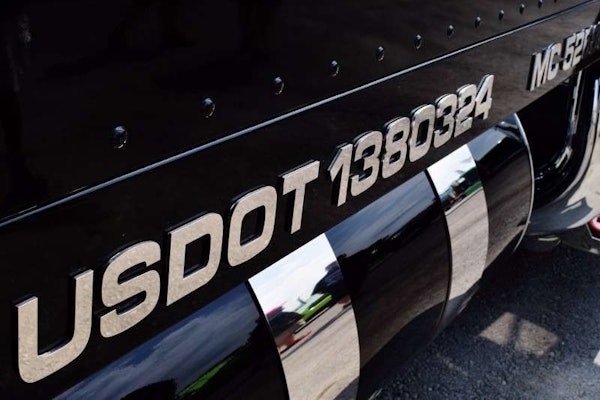Jeff Morrow might be the king of big loads.
Although he doesn’t drive the truck and he doesn’t steer the trailer, Morrow puts together some of the biggest and heaviest hauls in the country.
Morrow is special project head for Rootstown, Ohio-based Miller Transfer, a trucking company that specializes in oversized loads. One of Miller Transfer’s recent hauls involved an extra-heavy load in Alabama. Morrow and his team of six heavy-haul specialists moved the 150-ton base of an automotive press 120 miles, from a deep-water dock along the state’s Black Warrior River to a plant supporting Honda’s nearby automobile manufacturing facility.
The press – worth more than $30 million – was loaded on the back of Miller Transfer’s specially built trailer that features 16 hydraulic axles. The axles can expand the trailer’s width from 14 to 20 feet, and disperse the load over 104 feet. The $750,000 trailer, built by Nelson Manufacturing, is not only pulled by a four-axle tractor (only three were used for this haul), but pushed by a nearly identical bobtail.
A set of the trailer’s axles can also be steered, giving the trailer a tighter turning radius – 57 feet – than most trucks with 53-foot trailers. Morrow says this feature comes in handy when moving loads through cities.
Between gathering permits and negotiating a route, “it takes nearly a year to put a load like this together,” Morrow says. The press, which will create metal panels for Honda cars, was designed and assembled in Japan. After testing, it was taken apart, boxed up and shipped to New Orleans. From there, it went by barge to Mobile, Ala., then up the state’s river system to Cordova.
Trucker Mike Nichols takes charge of the load from the moment it is secured to the trailer. He pilots the unwieldy weight over railroad tracks (the trailer can be raised or lowered depending on the terrain) and around tight curves, always with eyes on mirrors, motorists and bridge abutments.
Before the trip, Nichols checks his truck, the trailer and the rear rig, giving the setup one of many thorough inspections. He consults with police escorts to determine strategy for traffic control. A tight rein must be kept on motorists throughout the trip to ensure safety. The whole team gathers to go over the route again verbally, and prepare mentally.
Morrow and Nichols have both driven the route dozens of times as the haul date approached, looking for changes due to things like construction. Nichols drove the route earlier in the day and has planned his last modifications. “We started planning this route months ago,” Morrow says. “We’ll find a route where we can get under all the obstacles, make it through all the turns and make it over all the bridges.”
The route is determined with the help of computers and the state. In this haul, no bridges had to be shored up, but the route was adjusted to miss bridges that might present problems.
The first part of the route was done at night to get the massive cargo through Birmingham, Ala.
At 10 p.m. July 11, Nichols, Morrow and crew fired up their two Kenworth tractors and began the arduous journey that included navigating snaky two-lane country roads and the heart of Birmingham’s freeway system, including the intersection of I-65 and I-59/20 informally dubbed “Malfunction Junction.”
The two W800s have Cummins engines boasting 500 horsepower or more. The back tractor pushes the trailer from the end of a 20-foot, 700-pound solid steel beam, while the lead tractor pulls the trailer from a bar attached to its frame. The two trucks feature solid frame beams that run from the front bumper to the back. One truck can haul the load, but it can’t maintain speed.
The trip featured dozens of stops and adjustments. Where a turn or tight curve was negotiated, Bill Morrison would hop up on a catwalk at the trailer’s rear and steer the trailer’s mid axle. The rear axle group can be hooked directly to the trailer’s superstructure for long straightaways, or float untethered with a steerer.
“It maneuvers very well for the size,” Morrison says. When asked if he minds being behind the 300,000-pound load, Morrison jokes, “I’d rather be on this end than that end.”
Farther behind Morrison, Roger Berg pilots the trailing truck. At stops he jokes with truckers on Channel 19 about the nature of the load. “Is that a UFO?” crackles one passing driver. Though a 1998 model, Berg’s truck has only 175,000 miles on it, but he says it’s not fair to compare his miles to those of regular truckers. “The miles are hard miles.”
Up front, Nichols’ truck is brand new, sporting only 1,500 miles since he picked it up from the factory. He says hauling heavy isn’t all that different from pulling a regular load, it just requires more patience, planning and time.
The 120-mile haul took nearly nine hours to complete, the last two hours covering only 10 miles. But Morrow says that’s a pretty good pace for a 150-ton load and 540,000 pounds worth of gross vehicle weight. He says the trip’s success depends on his team of heavy haulers, and the night runs smooth because of them.
“This is a pretty good team,” Morrow says. “Everybody knows what they’re supposed to do.”





